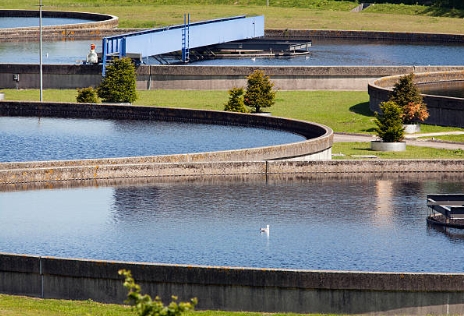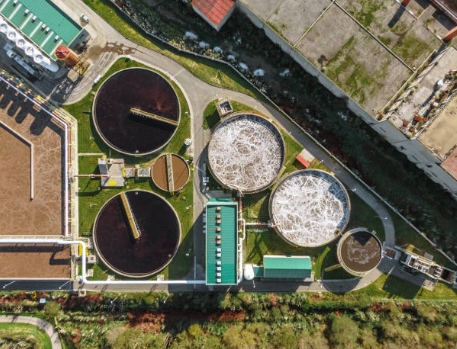Please Choose Your Language
Views: 222 Author: Carie Publish Time: 2025-04-07 Origin: Site








Content Menu
● The Stages of Water Purification
● Challenges and Future Directions
● FAQ
>> 1. What is the purpose of sewage treatment?
>> 2. How does biological treatment work?
>> 3. What happens to the sludge produced during treatment?
>> 4. Why is tertiary treatment necessary?
>> 5. Can treated wastewater be reused?
● Citation
Water purification at sewage treatment plants is a critical process for maintaining environmental balance and ensuring public health. These facilities treat wastewater from households, industries, and commercial establishments to remove contaminants, making the water safe for discharge into natural water bodies or reuse. The process involves a series of mechanical, biological, and chemical treatments designed to eliminate pollutants and pathogens. This article explores the stages of water purification in sewage treatment plants, detailing each process step and its significance.

Preliminary treatment is the first step in purifying wastewater. Its primary goal is to remove large debris and coarse solids that could interfere with subsequent processes.
- Screening: Large filtering screens trap items like sticks, plastics, and trash. This prevents clogging of pumps and pipes in the treatment plant.
- Grit Removal: Grit chambers separate heavy particles such as sand and gravel. These particles can wear down equipment if not removed early.
- Flow Measurement: Devices measure the flow rate of incoming wastewater to ensure efficient processing. This helps operators adjust treatment parameters based on the volume of wastewater.
This stage prevents pump blockages and enhances the efficiency of downstream treatments.
Primary treatment focuses on sedimentation and skimming to separate solid waste from liquid wastewater.
- Sedimentation: Heavy solids settle at the bottom of tanks, forming sludge. This sludge is later processed separately.
- Skimming: Lighter materials like oil and grease float to the surface and are skimmed off. This reduces the risk of these substances causing problems in subsequent treatment stages.
- Efficiency: About 60% of suspended solids are removed during this stage.
Secondary treatment uses biological processes to degrade dissolved organic matter.
- Activated Sludge Process: Bacteria and protozoa consume organic pollutants in aeration tanks. Oxygen is supplied to support microbial activity.
- Aeration: Air is introduced into the tanks to enhance microbial growth and activity. This process is crucial for breaking down organic compounds.
- Clarification: Settling tanks separate activated sludge from treated water. The sludge is recycled back into the aeration tanks to maintain a healthy microbial population.
This stage removes over 90% of suspended solids and organic pollutants.
Tertiary treatment is an advanced stage designed to remove remaining contaminants, including nutrients like nitrogen and phosphorus.
- Chemical Processes: Chemicals precipitate phosphates into insoluble compounds, which are then removed.
- Filtration: Microfiltration systems remove fine particles that escaped earlier stages.
- Disinfection: Chlorination or UV radiation eliminates pathogens, ensuring the water is safe for discharge or reuse.
The treated water is now safe for discharge into rivers, lakes, or reuse.
Sludge generated during primary and secondary treatments undergoes further processing:
- Thickening: Excess water is removed from sludge using belt thickeners or centrifuges. This reduces the volume of sludge for further treatment.
- Digestion: Anaerobic digestion breaks down organic matter in sludge, producing biogas as a by-product. Biogas can be used as energy.
- Disposal or Reuse: Treated sludge can be used as fertilizer or safely disposed of in landfills.
In recent years, advanced technologies have been integrated into sewage treatment to improve efficiency and reduce environmental impact:
- Membrane Bioreactors (MBRs): These systems combine biological treatment with membrane filtration, providing high-quality effluent.
- Advanced Oxidation Processes (AOPs): Techniques like UV/H2O2 are used to remove persistent organic pollutants.
- Biological Nutrient Removal (BNR): Processes designed to remove nitrogen and phosphorus more effectively.
These technologies enhance the sustainability and effectiveness of wastewater treatment.

Despite advancements, sewage treatment plants face challenges such as energy consumption, sludge management, and the presence of emerging contaminants like microplastics and pharmaceuticals. Future directions include:
- Energy Recovery: Implementing systems to recover energy from wastewater, such as biogas generation.
- Water Reuse: Promoting water reuse for non-potable purposes to conserve freshwater resources.
- Innovative Technologies: Developing new technologies to address emerging contaminants and improve treatment efficiency.
Sewage treatment plants play a vital role in protecting ecosystems and human health by purifying wastewater through mechanical, biological, and chemical processes. From screening debris to advanced filtration techniques, each stage ensures that contaminants are effectively removed. The treated water can then be safely discharged or reused, contributing to sustainable water management. As technology evolves, these facilities will continue to adapt, addressing new challenges and improving efficiency.

Sewage treatment removes contaminants from wastewater, making it safe for discharge into natural environments or reuse. It protects public health and prevents pollution.
Biological treatment uses microorganisms like bacteria to break down organic pollutants in aeration tanks. Oxygen is supplied to support microbial activity.
Sludge undergoes thickening and digestion processes. It can be used as fertilizer or safely disposed of after treatment.
Tertiary treatment removes nutrients like nitrogen and phosphorus that cannot be eliminated during secondary treatment. It also disinfects water to ensure safety.
Yes, treated wastewater can be reused for irrigation, industrial processes, or even as drinking water after advanced purification stages.
[1] https://wasserdreinull.de/en/knowledge/water-and-wastewater/wastewater-treatment/
[2] https://www.bmuv.de/en/topics/water-management/overview-water-management/wastewater/sewage-treatment-plant
[3] https://neoakruthi.com/blog/sewage-treatment-plant-process.html
[4] https://www.premiertechaqua.com/en-ie/wastewater/how-does-a-sewage-treatment-plant-work
[5] https://www.britannica.com/topic/water-purification
[6] https://www.britannica.com/technology/wastewater-treatment
[7] https://www.britannica.com/technology/wastewater-treatment/Primary-treatment
[8] https://www3.epa.gov/npdes/pubs/bastre.pdf
This article highlights the top stannous sulfate manufacturers and suppliers in the UK, focusing on their product quality, industrial applications, and market presence. It emphasizes the UK's strength in producing high-purity stannous sulfate for surface treatment, water treatment, and electroplating industries. Key players like REAXIS and Atotech lead the market with innovative solutions, while OEM support and regulatory compliance remain core advantages of UK suppliers. The article also addresses the compound's uses and includes a detailed FAQ to assist industry professionals.
Germany leads Europe in Stannous Sulfate manufacturing, supplying high-purity, reliable chemicals essential for electroplating, glass production, pharmaceuticals, and more. Key German suppliers like TIB Chemicals AG, MCC Menssing, Univar Solutions GmbH, and VMP Chemiekontor GmbH offer tailored solutions, strict quality control, and global distribution for diverse industrial demands.
This article explores the top stannous sulfate manufacturers and suppliers in Europe, highlighting leading companies like TIB Chemicals and Chimica Panzeri. It details production technologies, quality standards, industry applications, and OEM services, offering insights for markets requiring high-purity stannous sulfate chemicals.
This article explores the top stannous sulfate manufacturers and suppliers in France, highlighting their product quality, compliance with environmental standards, customized OEM services, and key industrial applications such as aluminum surface treatment, electronics, pharmaceuticals, and wastewater management.
This article explores the top stannous sulfate manufacturers and suppliers in America, detailing key companies, product forms, industries served, manufacturing processes, quality controls, and environmental considerations. It highlights the benefits of sourcing stannous sulfate locally with customization and technical support options. Insightful images illustrate stannous sulfate forms, production, and applications in industrial processes. Finally, a FAQ section addresses common queries related to stannous sulfate use and supply.
This comprehensive report explores Japan's top nickel sulfate manufacturers and suppliers, highlighting their production capabilities, market positions, and product applications. Featuring companies like Sumitomo Metal Mining and SEIDO Chemical Industry, the article delves into manufacturing processes, industry uses, and environmental practices, reflecting the pivotal role of Japanese firms in the advancing global nickel sulfate market.
South Korea is a leading global hub for nickel sulfate manufacturing, dominated by Korea Zinc and KEMCO with a combined annual capacity of 80,000 tons. Leveraging advanced smelting technologies and government-supported strategic status, these manufacturers supply high-quality nickel sulfate for electric vehicle batteries, surface treatment, and chemical industries. South Korean suppliers offer comprehensive OEM services to international clients, meeting growing global demand with innovation, sustainability, and quality.
This article provides a comprehensive overview of leading nickel sulfate manufacturers and suppliers in Portugal, covering their technological capabilities, product lines, market roles, and strict compliance with international standards. Highlighting diverse applications from electroplating to battery manufacturing, it showcases Portugal’s growing importance in the global nickel sulfate supply chain. Accompanied by relevant images, the article emphasizes sustainability, innovation, and quality as cornerstones of the Portuguese chemical sector.
This article explores the top nickel sulfate manufacturers and suppliers in Spain, highlighting their product offerings, quality standards, and strategic advantages. It covers Spanish industry applications, OEM services, and explains why Spain is a preferred sourcing hub for global chemical buyers. The article also includes detailed FAQs and relevant images to provide a comprehensive understanding of the nickel sulfate market in Spain.
Italy’s nickel sulfate manufacturing and supply chain is advanced, diverse, and globally integrated—supporting key industries like batteries, electroplating, and catalysts. With leading companies, customized services, and sustainable practices, Italian nickel sulfate manufacturers and suppliers are crucial to meeting the world’s growing demand for this essential chemical.
This article provides an in-depth overview of the top nickel sulfate manufacturers and suppliers in Russia, focusing on major companies like Norilsk Nickel, their production processes, market presence, environmental initiatives, and the diverse industrial applications of nickel sulfate. It serves as a valuable resource for international businesses looking to source high-quality nickel sulfate from Russia.
Aluminum alloys have become indispensable materials in modern industry, owing to their light weight, high strength-to-weight ratio, corrosion resistance, workability, and versatility. However, their durability—especially when used in challenging environments—is critically dependent on
Electrophoretic coatings, often referred to as *E-coatings* or *electrophoretic deposition (EPD)*, have revolutionized surface finishing in the modern manufacturing landscape. They blend chemistry, material science, and advanced technology to create coatings that are durable, uniform, and environmen
Discover Europe's most prominent Nickel Sulfate Manufacturers and Suppliers, including sustainability-focused innovators and rapid-response distributors serving the EV, electroplating, and advanced materials sectors. Learn about top companies, key trends, market drivers, and FAQs to inform your industrial chemical sourcing decisions. This comprehensive guide highlights the critical role nickel sulfate plays in Europe’s green industrial future.
This article details France’s leading role in nickel sulfate production, covering major manufacturers and suppliers, innovative production methods, sustainability commitments, and the industry’s critical role in green technology supply chains. It also examines market drivers, regulatory compliance, and supply chain strategies while answering common industry questions. The content is especially relevant for businesses seeking OEM solutions for aluminum profile treatment and battery production.
This comprehensive guide details the leading Nickel Sulfate Manufacturers and Suppliers in Germany, highlighting their strengths, product applications, and why Germany is a global leader. It covers selection criteria, market trends, and answers to key FAQs for buyers and industry professionals.
This article offers a comprehensive guide to the UK’s top Nickel Sulfate Manufacturers and Suppliers, highlighting industry applications, leading brands, and sourcing strategies in the rapidly growing British and global markets. From surface finishing to electric vehicle batteries, discover how to select the right partner and stay ahead of industry shifts.
This article explores the top Nickel Sulfate Manufacturers and Suppliers in America, highlighting their key products, application areas, and essentials of reliable sourcing. With detailed industry profiles, market trends, future outlooks, and FAQs, it serves as a vital comprehensive resource for businesses seeking high-quality nickel sulfate and dependable partnership.
Choosing the best chemical raw materials for aluminum profiles is **critical to ensuring strength, durability, corrosion resistance, and sustainability** in the final products. The selection impacts not only the mechanical and aesthetic qualities but also influences cost-effectiveness, production ef
In the global industrial landscape, **chemical raw materials for surface treatment** play a critically transformative role in enhancing the durability, functionality, and aesthetics of countless products. Surface treatment chemicals help prevent corrosion, improve adhesion, increase wear resistance,
